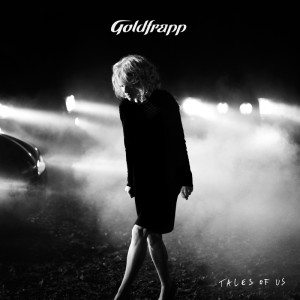Tales of Us
 One of Goldfrapp’s biggest strengths has always been the project’s acts of reinvention. Each album thus far has had its own delicately-crafted (and distinct) presence, and taken in sequence, listeners have been presented with a solid discography of bold records, which have helped cement Goldfrapp’s position as one of the most influential electronica bands of the past decade or so.
One of Goldfrapp’s biggest strengths has always been the project’s acts of reinvention. Each album thus far has had its own delicately-crafted (and distinct) presence, and taken in sequence, listeners have been presented with a solid discography of bold records, which have helped cement Goldfrapp’s position as one of the most influential electronica bands of the past decade or so.
Sadly, the duo’s previous album – 2010’s Head First – couldn’t help but feel like a disappointing attempt to be a part of the ’80s revival craze which was in full flow at the time: a blip made even more disappointing when one considers how pioneering the musicians had been with previous albums, such as the sharp electro-glam of 2003’s Black Cherry. Perhaps reacting against this blip themselves, they seem to have ditched the synthesisers entirely for their sixth studio album, instead returning to the folk-inspired, down-tempo softness of 2008’s Seventh Tree. Indeed, Tales of Us could arguably be coined to be an amalgamation of the natural acoustic sounds of that album, with the haunting cinematic visions of the group’s debut Felt Mountain (2000).
The result is an album which sounds achingly intimate. Each track is named after a person; the lyrics telling abstract fairytales which almost feel like entries pulled from a diary. Descriptions of sparse wintry landscapes abound, epitomised in lines such as “Where the camphor grows / Where the moon and freedom sigh”. Yet beneath it all beats a sinister heart: one track entitled ‘Alvar’ describes a beloved figure’s mysterious disappearance, while opening track ‘Jo’ features the film noir-esque story of gunshots in the night. ‘Thea’ provides an even more foreboding scene, focusing on a couple being pursued through a rainy night, as tensions strain between them. The song’s rippling synths are the only obvious moments of electronic influences on the album, which thus makes their presence all the more disconcerting.
The flow of the album creates an intriguing soundscape, but a lack of easy distinction between songs mean they all begin to blur into a whisper: heard intently, but quickly forgotten.
Overall, most songs are characterised by a longing for lost love affairs: blurred memories of time spent with lovers on long-gone summer days. Despite such rather downbeat content, many songs are genuinely gorgeous to hear. ‘Drew’ begins with only the sound of an acoustic guitar, before gradually building with layers of strings offering sweeping melodies, and forming something surprisingly moving in the process. In addition, Tales of Us is Goldfrapp’s most texturally consistent album, with all tracks relying mostly on atmospheric string arrangements. This minimalism allows Alison Goldfrapp’s whispered falsetto vocals to stand out fully, and these are some of the greatest performances she has ever recorded. The ultimate experience is rather cinematic, almost as if the listener is being gently draped in soft materials.
But it is here that problems arise. Whilst I wasn’t expecting any radio-friendly dance-pop tracks, there is a severe lack of standout songs here, and consequently, one listens to the whole album as if in a trance. The whole album flows well, creating an intriguing soundscape, but one that remains generally impenetrable. Multiple listens are sure to coax out the personalities of individual cuts, but a lack of easy distinction between them means they all begin to blur into a whisper; heard intently, but quickly forgotten.
Avid Goldfrapp fans will likely be pleased with Tales of Us, but more casual listeners might be left feeling underwhelmed, instead hoping for more of the engaging electro beats which the duo have excelled in previously.
Similar To: Bjӧrk, Moloko
MP3: ‘Drew’, ‘Annabel’

Comments